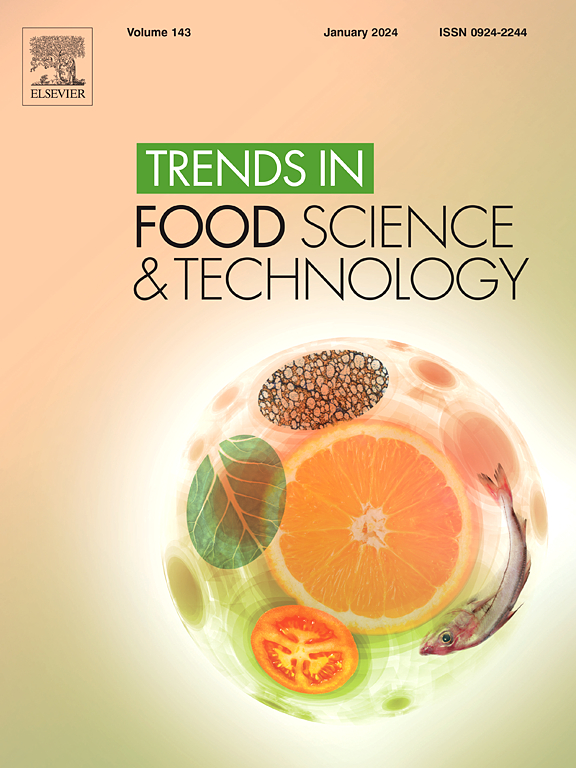探索食物来源的生物活性肽:铁下垂调节的功效、机制和临床意义
IF 15.1
1区 农林科学
Q1 FOOD SCIENCE & TECHNOLOGY
引用次数: 0
摘要
从食物蛋白质中提取的生物活性肽(BAPs)已成为具有潜在健康益处的重要营养成分。最近的研究表明,它们调节与铁下垂相关的细胞过程,铁下垂是一种与各种疾病相关的受调节的细胞死亡形式。本文综述了BAPs的来源、生产、稳定性、生物利用度和临床疗效等方面的最新进展。此外,本文还探讨了BAPs潜在的抗铁下垂机制,包括谷胱甘肽合成、氧化应激、铁代谢和甲羟戊酸途径。主要发现:有证据表明,BAPs通过增强抗氧化防御和维持细胞稳态而具有显著的抗铁致凋亡作用。此外,机制见解揭示了BAPs影响铁下垂的关键信号通路,从而提供了潜在的治疗靶点。BAPs在铁下垂调节中的临床意义是重大的,特别是对于急性肾损伤、炎症性肠病、神经退行性疾病和急性肺损伤等疾病。然而,尽管BAPs作为饮食干预的潜在应用是有希望的,但其生物利用度和稳定性方面的挑战需要解决,以促进其在临床实践中的应用。本文章由计算机程序翻译,如有差异,请以英文原文为准。

Exploring food-derived bioactive peptides: Efficacy, mechanisms, and clinical implications in ferroptosis regulation
Background
Bioactive peptides (BAPs) derived from food proteins have emerged as important nutritional components with potential health benefits. Recent studies have suggested that they modulate cellular processes related to ferroptosis, a regulated form of cell death that has been associated with various diseases.
Scope and approach
This review summarizes recent advances in the sourcing, production, stability, bioavailability, and clinical efficacy of BAPs. Furthermore, the potential antiferroptosis mechanisms of BAPs, including glutathione synthesis, oxidative stress, iron metabolism, and the mevalonate pathway, are explored.
Key finding
s: Evidence suggests that BAPs produce significant antiferroptotic effects by enhancing antioxidant defenses and maintaining cellular homeostasis. In addition, mechanistic insights reveal that BAPs influence the key signaling pathways involved in ferroptosis, thus offering potential therapeutic targets. The clinical implications of BAPs in ferroptosis regulation are substantial, particularly for conditions such as acute kidney injury, inflammatory bowel disease, neurodegenerative diseases, and acute lung injury. However, although the potential applications of BAPs as dietary interventions are promising, challenges associated with their bioavailability and stability require addressal to facilitate their use in clinical practice.
求助全文
通过发布文献求助,成功后即可免费获取论文全文。
去求助
来源期刊

Trends in Food Science & Technology
工程技术-食品科技
CiteScore
32.50
自引率
2.60%
发文量
322
审稿时长
37 days
期刊介绍:
Trends in Food Science & Technology is a prestigious international journal that specializes in peer-reviewed articles covering the latest advancements in technology, food science, and human nutrition. It serves as a bridge between specialized primary journals and general trade magazines, providing readable and scientifically rigorous reviews and commentaries on current research developments and their potential applications in the food industry.
Unlike traditional journals, Trends in Food Science & Technology does not publish original research papers. Instead, it focuses on critical and comprehensive reviews to offer valuable insights for professionals in the field. By bringing together cutting-edge research and industry applications, this journal plays a vital role in disseminating knowledge and facilitating advancements in the food science and technology sector.
 求助内容:
求助内容: 应助结果提醒方式:
应助结果提醒方式:


